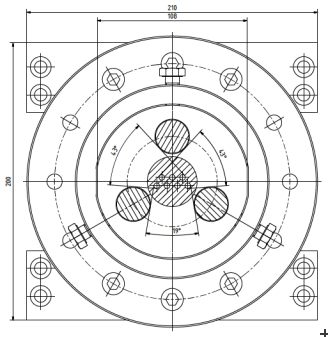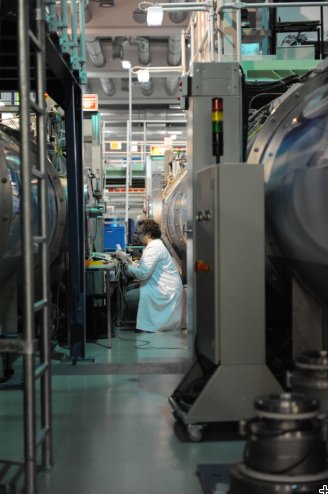Copyright 2012 neutronsources.org | All rights reserved. | Powered by FRM II | Imprint / Privacy Policy
To broaden research possibilities: a new pressure cell
Henrich Frielinghaus and Marie-Sousai Appavou from the JCNS-MLZ are developing a new pressure cell. This work, which is funded by NMI3, will broaden the research possibilities in several scientific fields.
26/02/2014
The importance of pressure cells
Pressure cells are valuable tools for neutron scattering because they make it possible to analyse samples under preselected pressure conditions where they are more stable. We’ve talked with Marie-Sousai Appavou, who is an instrument scientist of the KWS-2 Small angle scattering diffractometer at the Jülich Centre for Neutron Science (JCNS) – MLZ near Munich, to learn about these important tools.
He explained that pressure cells are contributing to advance a range of scientific fields. For instance, degenerative diseases like Alzheimer are caused by misfolded proteins. Thanks to pressure studies, researchers may find new folding pathways, and with this kind of knowledge they might be able to delay these diseases in the future. Furthermore, thanks to research with pressure cells, it is possible to sterilise sea food in Japan, fruit juice and smoothies in France and the U.S.A., and other products in an increasing number of countries. Another idea for the future would be to conduct pressures studies to find new ways to clean the sea water after an oil spill.
Interview with the task coordinator
Henrich Frielinghaus from JCNS is the leader of the task Kinetic/dynamic measurements in periodic external fields of the NMI3 Joint Research Activity (JRA) Advanced Neutron Tools for Soft and Bio-Materials . Together with Appavou, he is in charge of developing a non-magnetic pressure cell able to accept a large incoming beam cross section and large exit angles. In this short interview, he tells us about this work.
Inês Crespo: Please tell us about your work within your NMI3 JRA.
Henrich Frielinghaus: When we set up the programme, we quickly learned there is a huge demand for high-end sample environment in the field of soft matter research. Only by providing the latest developments to external users and in-house research, we would serve the desired output of cutting edge publications and increase the awareness of neutron scattering in the scientific community. One weak point – and much desired tool in our group was that we didn’t have a suitable pressure cell for neutron spin echo (NSE) spectroscopy and small angle neutron scattering (SANS). So we at JCNS could propose this demanding task as part of this JRA, and quickly started the first developments.
What are the biggest challenges?
The biggest challenges were the physical limits of constructing a pressure cell. All known materials have a natural stress limit, and practical constructions underbit these limits depending on the technical details. Here, a huge amount of know-how and discussions are needed. The regular meetings within the NMI3 project are the platform for providing the desired exchange.
What are the biggest advantages?
Apart from our own developments, other JRA task groups develop their own constructions for completely different purposes, but: The other constructions complete the desired sample environment that is useful for our JCNS group at the Heinz Maier Leibnitz Zentrum in Garching, too. We are a big family with much in common.
How is your work within this JRA progressing? Any results so far?
During our discussions we started to philosophize about the most suitable window material for pressure cells, which must be transparent for neutrons but mechanically extremely strong. Eddy Lelièvre-Berna from the Institut Laue-Langevin (ILL) had already experience with pressure cells for conventional solid state physics and engineering problems and used the alloy Titanium-Zirconium (TiZr). The LLB tested this material already in a SANS experiment and discovered its usefulness for scattering angles above ca. 0.08Å-1, which is the dedicated range for typical NSE measurements. Eddy, by chance, had quite some material on stock and was willing to provide one ingot to us. So we could quickly obtain this valuable material and using our own construction plans we manufactured two kinds of windows for a NSE and a SANS cell at once. For the SANS cell we checked the background scattering of TiZr in comparison to the existing sapphire windows, and found them suitable for many soft matter samples. They would not break as easily as the brittle sapphire. For the NSE cell, first tests are on the agenda for the next weeks.
How do you see the future of these technologies?
Pressure is interesting for many topics in soft matter and biology, such as microemulsions and denaturation of proteins. Microemulsions are used in soil cleaning, where they are pumped at elevated pressures to the ground to dissolve unwanted contaminants. Not all responses of microemulsion to pressure are known and need to be explored. The first SANS and NSE measurements have been performed by Japanese groups, but other interesting topics like salinity and polymeric additives have not been studied in the context of pressure. Apart from that, for the future, near surface structure and dynamics information is desired, since the contaminated soil involves huge surfaces to the cleaning process. Denaturation of proteins by pressure is interesting as such in sterilization and conservation processes. In parallel, one would like to unfold and back-fold the protein very precisely by pressure, to obtain the precise information about the energetic landscape by analysing the structure and dynamics of each intermediate stage. For the future of protein unfolding, highest pressures of 7 to 8 kbars would be desired, but are only reached in technical feasibility tests.
What are the advantages of taking part in a project supported by NMI3?
The high motivation of each participant to contribute to the best results leads to cumulative effects. The regular meetings are the platform for discussing small problems and stagnations. We are a big family with a common aim: to achieve the best sample environment for cutting edge neutron experiments at all European neutron facilities.

